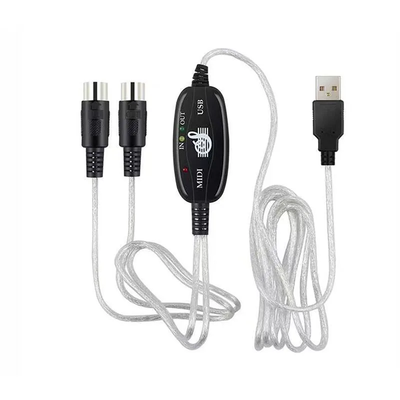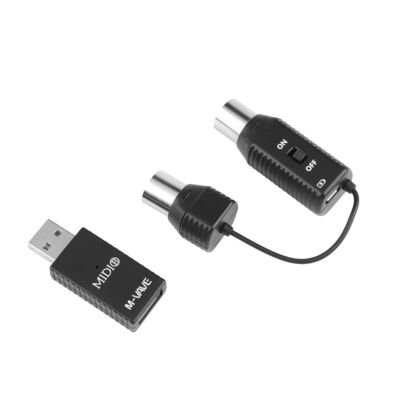USB-MIDI cables
TL;DR Stay away from cheap USB-MIDI cables off the Internet! Invest in a cable that is known to work correctly. See below for some suggestions.
We're dealing with legacy hardware here — the original POD was released in 1998, POD 2.0 came in 2000 and PODxt came in 2002. While PODxt already features a USB port, the only way to connect older PODs to your computer is using MIDI cables. MIDI cables require a sound card with MIDI IN/OUT ports, which not many hobbyist guitar players have.
Luckily, one can nowadays get a relatively cheap USB-MIDI cable. The problem is, not all of them will work.
MIDI standard is not very complex and contains a variety of short messages,
such as Control Change CC messages, which are sent when you press or
release a key on the synthesizer or turn a knob on a POD or Program Change
PC messages, which are sent when you switch presets on a POD. For anything
more complex, System Exclusive SysEx messages are used. These are long
manufacturer-specific messages can are used to identify devices and
upload/download patches.
When buying cheap USB-MIDI cables off the Internet, please be aware that
there may be issues with the longer SysEx messages sending and receiving:
-
Data Loss:
SysExmessages can be quite long and complex, and cheaper USB-MIDI cables may not be able to reliably transmit all the data in the message. This can result in lost data or incomplete messages. -
Timing Issues:
SysExmessages require precise timing to be properly received by the target device, and cheap USB-MIDI cables may not be able to reliably maintain the required timing accuracy. This can lead to errors or failed messages. -
Buffer Overflow: Some MIDI devices have limited buffer sizes, and sending a large
SysExmessage can cause the buffer to overflow. Cheap USB-MIDI cables may have buffer overflow issues, leading to failed or missing messages.
In summary, sending SysEx messages using cheap USB-MIDI cables can
be problematic, and it is advisable to invest in a higher-quality cable
to ensure reliable and accurate data transfer.
When working with USB-MIDI cables, Windows users are generally advised to
try the winrt build first as it uses a newer MIDI driver stack that is
in constant development and support and may work better in newer versions
of Windows.
What is known to work
From my own experience and the experience of the pod-ui users, here are some USB-MIDI cables that are known to work:
M-Audio MIDISport Uno is a very affordable USB-MIDI cable, which
supports SyxEx message sending and works with all platforms.
Bespeco BM100 is another cheap USB-MIDI cable that is known to work.
Window users need to use the winrt build to get it working.
DOREMiDi MTU-11 is an inexpensive MIDI to USB-C cable that has been proven to work, tested on a MacBook Pro M1. DOREMiDi manufactures a variety of MIDI cables and boxes. Based on the experience with MTU-11, I would expect all of them to work correctly.
What may work
Here are some more options of good quality USB-MIDI cables that
the Interned agrees will support SysEx messages:
Roland UM-ONE MK2 is not the cheapest cable around, but is
widely regarded as one of the most reliable and stable options for
when SysEx messages are concerned.
iConnectivity mio and mio XC are other examples of not so
cheap, but quality products that are reported to support SysEx
messages, MIDI Time Code MTC and other advanced MIDI features.
Yamaha UX16 is one of the pricier options, but it is known
to work reliably with SysEx messages.
MOTU FastLane USB MIDI interface is not exactly a 1-to-1
USB-MIDI cable like the rest of the devices on the list, but for
the sake of completeness, it is worth to mention that is device
is known for its low-latency performance and reliable SysEx
messaging capabilities.
Please also check this VGuitarForums post for more quality devices.
Bluetooth MIDI adapters
Nowadays, there are plenty of wireless MIDI plugs that either use Bluetooth or ad-hoc wireless communication with a dongle you attach to a computer. Generally, these are more expensive that the USB-MIDI cables.
As with USB-MIDI cables, YMMV!
Yamaha MD-BT01 Bluetooth MIDI adapter is supposed to support
SysEx messages.
Roland WM-1 Bluetooth MIDI adapter is supposed to work
well. According to the manufacturer's website, you also need
a WM-1D dongle for Windows.
Quicco Sound mi.1 Bluetooth MIDI adapter is supposed to work.
What doesn't work
Generic MIDI controller off AliExpress

The cheap generic cable you get off AliExpress that looks like this
doesn't work with SysEx messages. I know, because I have one.
The device identifies as 1a86:752d QinHeng Electronics CH345 MIDI adapter.
Ironically, I bought it when I dusted off my POD 2.0 and started
working on pod-ui to not have to use an external USB sound card
with a proper MIDI cable. I've not been able to get it to transfer
SysEx messages on any platform.
Frank Buß has an excellent analysis of this device.
M-Vave MS-1

M-Vave MS-1 is a very affordable Bluetooth MIDI device, which,
unfortunately, doesn't quite work. When using an MS-1, the POD
will be correctly identified, but getting the patches from the
device and storing them back doesn't work. This probably means
that SysEx messages, as such, work, but the buffer is way too
small, so larger SysEx messages don't fit.
What can I do if my cable doesn't work with SysEx
If the cable doesn't support SysEx messages, you won't be able
to auto-detect the device using pod-ui (or test the connection
in the settings dialog). You won't be able to get the list of
patches from the device, and you won't be able to store/retrieve
individual patches from the device.
You will still be able to switch presets and adjust individual controls. Pod-ui will also react when you switch presets on the POD or adjust controls on it.